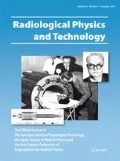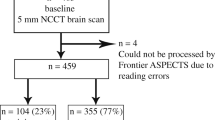Abstract
Our purpose in this study was to develop a computer-aided detection scheme for identification of hypoattenuation of acute stroke on unenhanced CT images to select patients for thrombolysis of acute stroke. This method is based on a z-score mapping method. The algorithm of the developed method consisted of five main steps: anatomic standardization, calculation of the z-score with a normal reference database, extraction of candidate voxels for hypoattenuation, feature extraction, and classification. The territory of the middle cerebral artery was divided into ten specified regions, according to a visually quantitative CT scoring system, the Alberta Stroke Programme Early CT Score (ASPECTS) method. Each of the ASPECTS-defined regions was classified as hypoattenuation or normality by linear discriminate analysis. The method was applied to 26 patients who had hypoattenuation areas (<6 h). The performance of this scheme for classification of hypoattenuation was evaluated using a leave-one-case-out method. As a result, an average sensitivity of 89.7% and an average specificity of 85.2% for automatically classifying hypoattenuation regions in the lentiform nucleus and the insular regions were obtained, and the average accuracy for the classification of hypoattenuation per patient was 84.6% (range 55.6–100%). The newly developed method has the potential accurately to identify hypoattenuation of acute stroke in the ASPECTS-defined regions.





Similar content being viewed by others
References
The National Institute of Neurological Disorders and Stroke rt-PA Stroke Study Group: tissue plasminogen activator for acute ischemic stroke. N Engl J Med. 1995;333:1581–7.
Adams H, Adams R, del Zoppo G. Guidelines for the early management of patients with ischemic stroke: 2005 guidelines update a scientific statement from the Stroke Council of the American Heart Association/American Stroke Association. Stroke. 2005;36:916–23.
Adams HP Jr, Adams RJ, Brott T, del Zoppo GJ, Furlan A, Goldstein LB, et al. Guidelines for the early management of patients with ischemic stroke: a scientific statement from the Stroke Council of the American Stroke Association. Stroke. 2003;34:1056–83.
Balbel PA, Demchuk AM, Zhang J, Buchan AM. Validity and reliability of a quantitative computed tomography score in predicting outcome of hyperacute stroke before thrombolytic therapy. Lancet. 2000;355:1670–4.
Schriger DL, Karafut M, Starkman S, Krueger M, Saver JL. Cranial computed tomography interpretation in acute stroke: physician accuracy in determining eligibility for thrombolytic therapy. JAMA. 1998;279:1293–7.
Wardlaw JM, Mielke O. Early signs of brain infarction at CT: observer reliability and outcome after thrombolytic treatment-systematic review. Radiology. 2005;235:444–53.
Takahashi N, Tsai DY, Lee Y, Kinoshita T, Ishii K. Z-score mapping method for extracting hypoattenuation areas of hyperacute stroke in unenhanced CT. Acad Radiol. 2010;17:84–92.
Takahashi N, Tsai DY, Lee Y, Kinoshita T, Ishii K, Tamura H, et al. Usefulness of z-score mapping for quantification of extent of hypoattenuation regions of hyperacute stroke in unhanded CT: analysis of radiologists’ performance. Comput Assist Tomogr. 2010;34:751–6.
Friston KJ, Ashburner J, Frith CD, Poline JB, Heather JD, Frackowiak RSJ. Spatial registration and normalization of images. Hum Brain Mapp. 1995;3:165–89.
Ashburner J, Friston KJ. Nonlinear spatial normalization using basis functions. Hum Brain Mapp. 1999;7:254–66.
Tomura N, Uemura K, Inugami A, Fujita H. Early CT findings in cerebral infarction: obscuration of the lentiform nucleus. Radiology. 1988;168:463–7.
Truwit CL, Barkovich AJ, Gean-Marton, Hibri N, Norman D. Loss of the insular ribbon: another early CT sign of acute middle cerebral artery infarction. Radiology. 1990;176:801–6.
Na DG, Kim EY, Ryoo JW, Lee KH, Roh HG, Kim SS, et al. CT sign of brain swelling without concomitant parenchymal hypoattenuation: comparison with diffusion- and perfusion-weighted MR imaging. Radiology. 2005;235:992–8.
Author information
Authors and Affiliations
Corresponding author
About this article
Cite this article
Takahashi, N., Lee, Y., Tsai, DY. et al. Computer-aided detection scheme for identification of hypoattenuation of acute stroke in unenhanced CT. Radiol Phys Technol 5, 98–104 (2012). https://doi.org/10.1007/s12194-011-0143-0
Received:
Revised:
Accepted:
Published:
Issue Date:
DOI: https://doi.org/10.1007/s12194-011-0143-0




